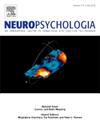自然运动中时间和空间合理性的神经编码:一项清醒猴子功能磁共振成像研究。
IF 2
3区 心理学
Q3 BEHAVIORAL SCIENCES
引用次数: 0
摘要
时间是单向流动的,这是人类认识到的物理约束,正如谚语中所反映的那样,“牛奶洒了,哭不了”。我们实验室最近的工作表明,人类参与者依靠特定的线索来区分时间箭头的方向,通过功能性磁共振成像(fMRI)识别神经网络对时间方向性的选择。这些神经基础可能是跨物种共享的,因为时间的物理约束是普遍存在的,即使其他物种可能不“承认”这是一条定律。在这项研究中,我们通过向猴子展示在三种条件下的生物和非生物运动的视频片段,研究了非人类灵长类动物的大脑是否以及如何编码生物和非生物运动在时间和空间领域的自然动态(合理性):(1)正常(向前和直立),(2)时间反转,(3)空间反转。全脑分析显示,颞上沟(STS)优先响应向前、直立的生物运动,反映了在时间和空间领域对自然动力学(合理性)的敏感性。在STS中,在两只猴子身上观察到一致的前后梯度:时间可信性编码在后,空间可信性编码在前,两者都在中间区域。这些结果表明,灵长类动物STS有选择性地调整到生物运动的自然动态,其后亚区有助于评估时间合理性,这可能是特定感知环境下时间方向判断的基础。本文章由计算机程序翻译,如有差异,请以英文原文为准。
Neural encoding of temporal and spatial plausibility in naturalistic motion: an awake monkey fMRI study
Time flows in one direction, a physical constraint humans recognize, as reflected in proverbs such as “there is no crying over spilt milk.” Recent work from our laboratory has demonstrated that human participants rely on specific cues to discriminate the direction of time's arrow, with functional magnetic resonance imaging (fMRI) identifying neural networks selective for temporal directionality. These neural bases are likely shared across species, as the physical constraint of time is universal, even if other species may not “recognize” it as a law. In this study, we investigated whether and how the non-human primate brain encodes the naturalistic dynamics (plausibility) of biological and non-biological motion in temporal and spatial domains by presenting monkeys with video clips of biological and non-biological motion under three conditions: (1) normal (forward and upright), (2) temporally reversed, and (3) spatially inverted. Whole-brain analyses revealed that the superior temporal sulcus (STS) preferentially responded to forward, upright biological motion, reflecting sensitivity to naturalistic dynamics (plausibility) in both temporal and spatial domains. Within the STS, a consistent posterior-to-anterior gradient was observed in both monkeys: temporal plausibility was encoded posteriorly, spatial plausibility anteriorly, and both in the intermediate region. These results suggest that the primate STS is selectively tuned to the naturalistic dynamics of biological motion, with its posterior subregion contributing to the evaluation of temporal plausibility, which may underlie time-direction judgments in specific perceptual contexts.
求助全文
通过发布文献求助,成功后即可免费获取论文全文。
去求助
来源期刊

Neuropsychologia
医学-行为科学
CiteScore
5.10
自引率
3.80%
发文量
228
审稿时长
4 months
期刊介绍:
Neuropsychologia is an international interdisciplinary journal devoted to experimental and theoretical contributions that advance understanding of human cognition and behavior from a neuroscience perspective. The journal will consider for publication studies that link brain function with cognitive processes, including attention and awareness, action and motor control, executive functions and cognitive control, memory, language, and emotion and social cognition.
 求助内容:
求助内容: 应助结果提醒方式:
应助结果提醒方式:


